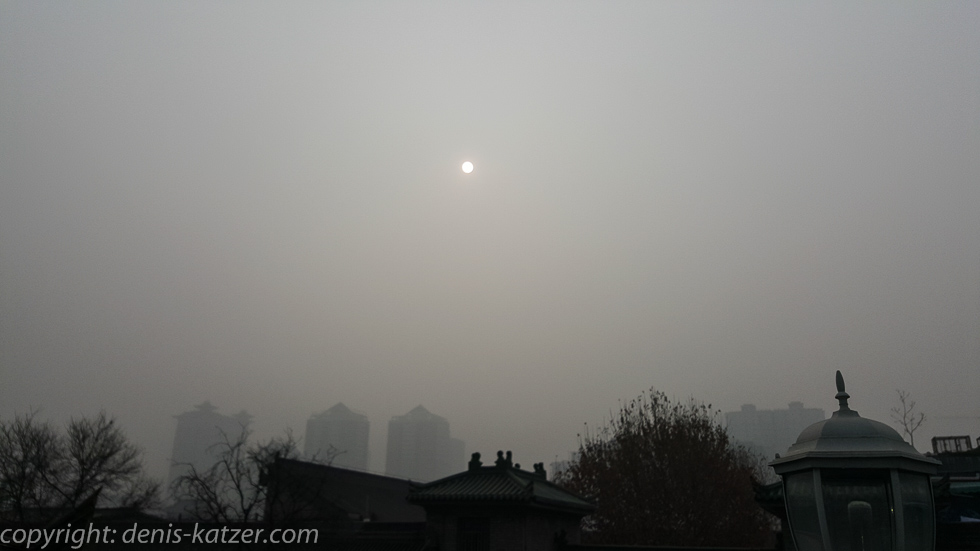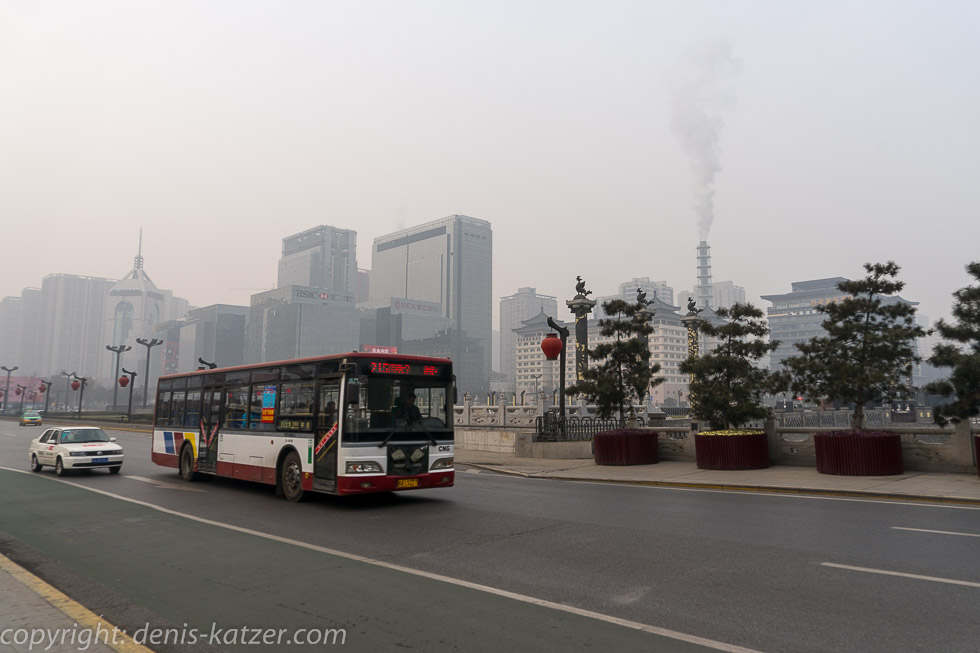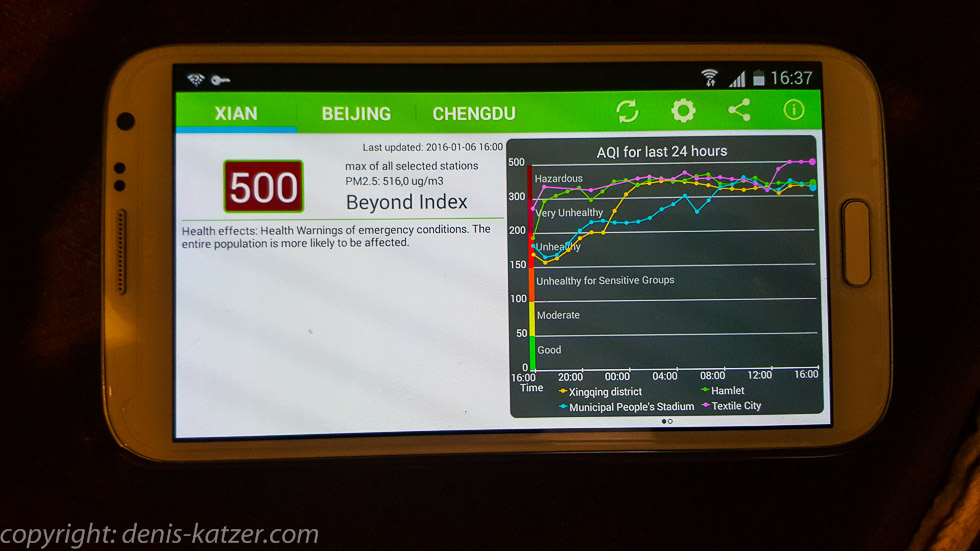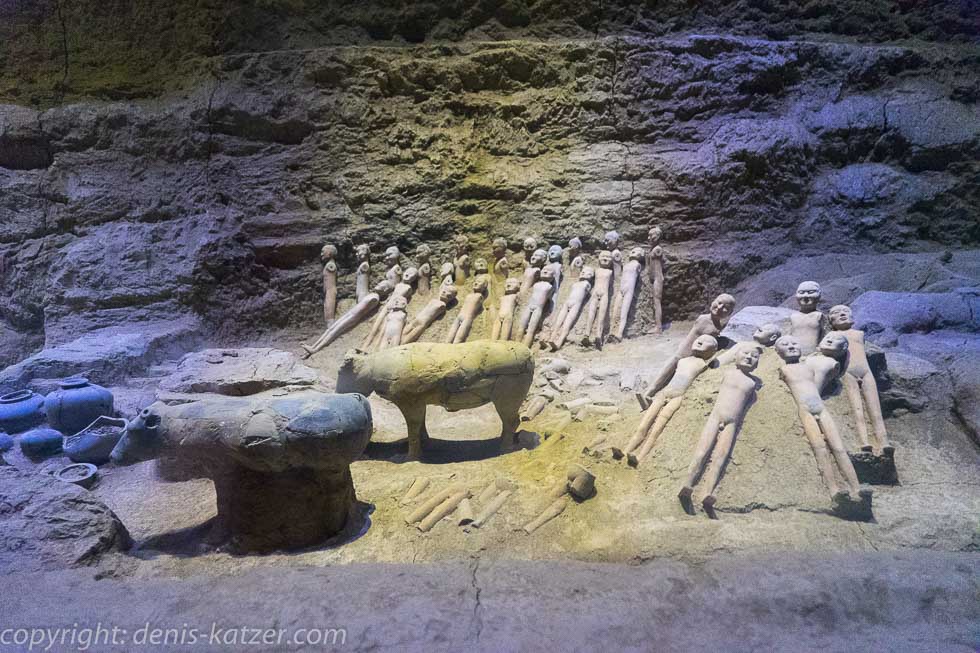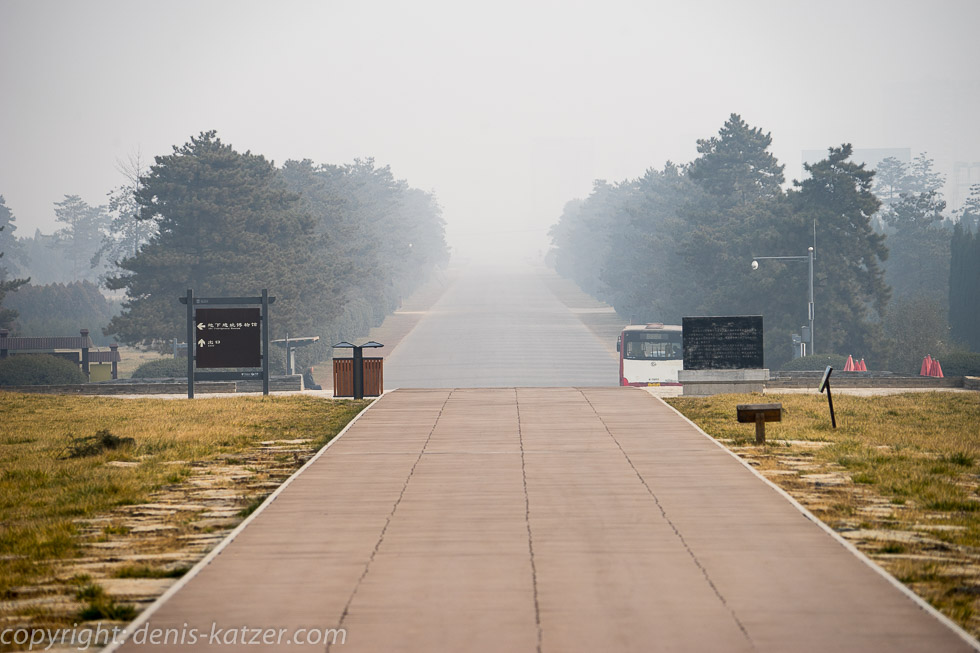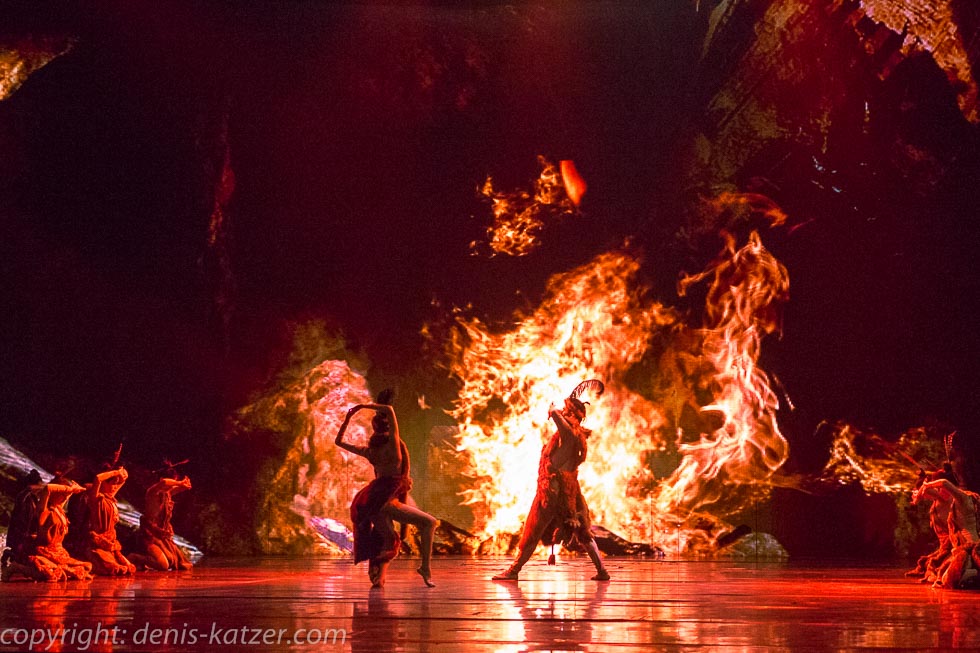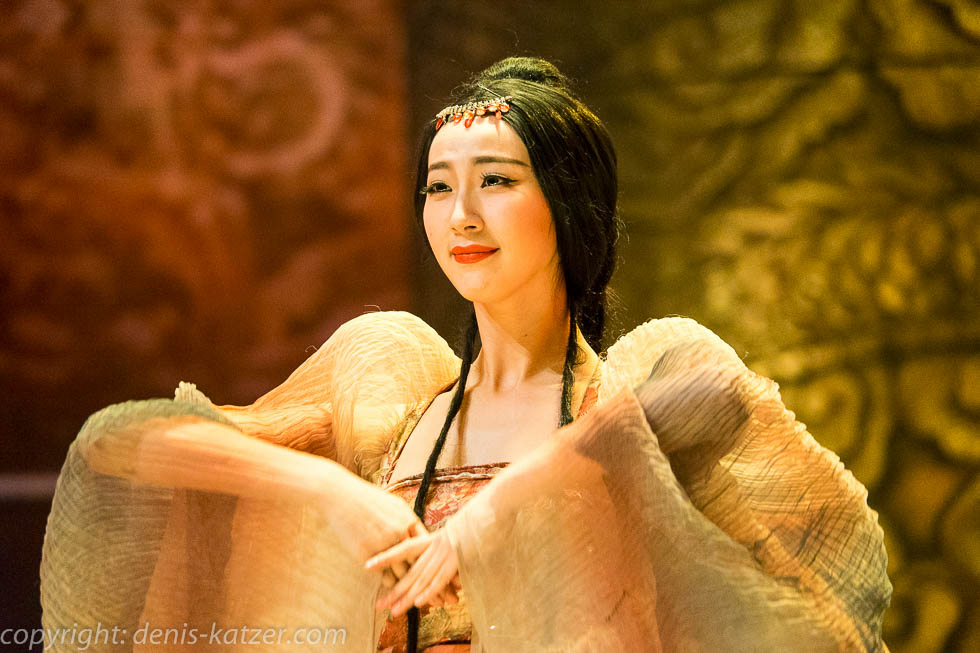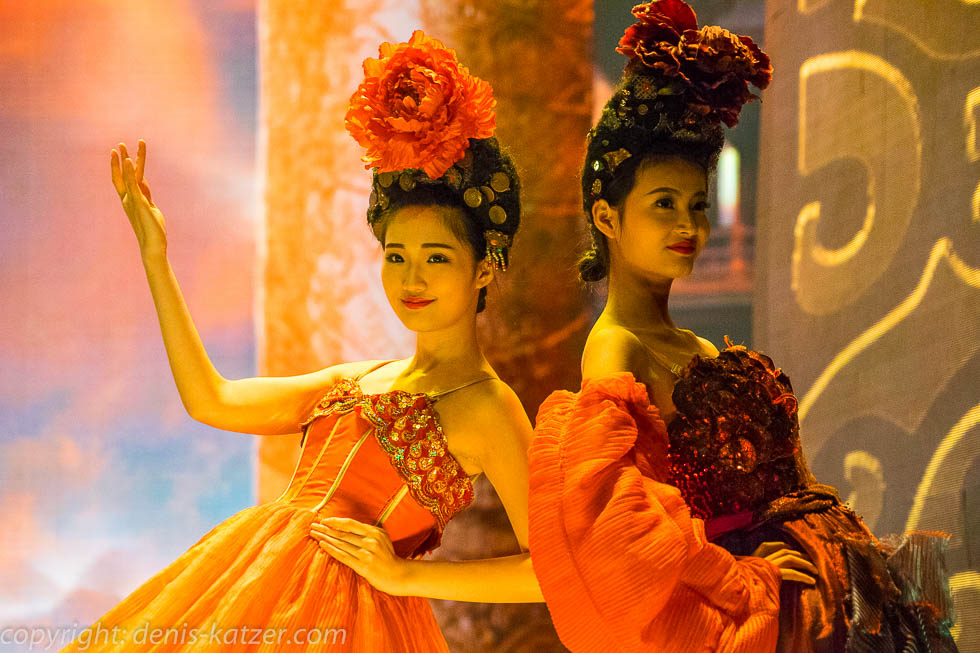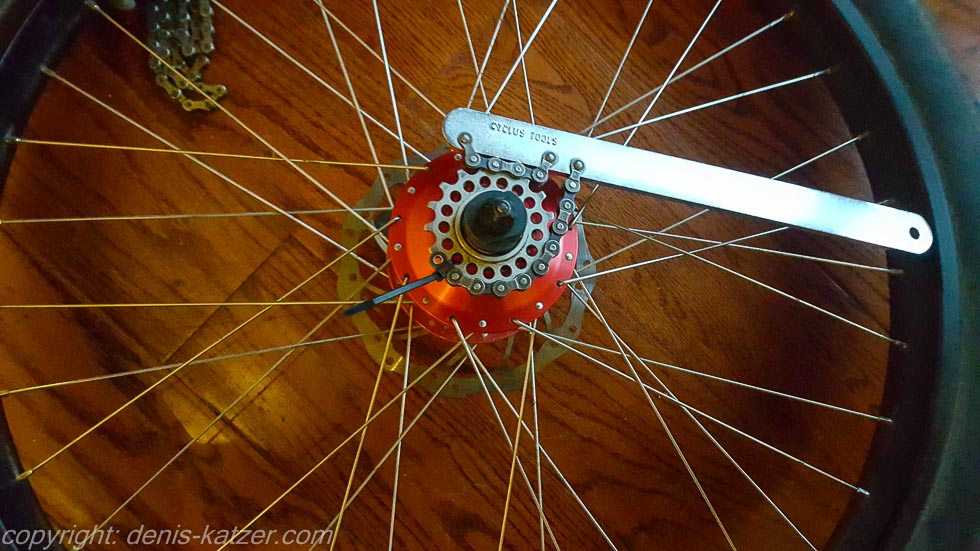
Tactics to escape the smog – gear change and peaceful emperor
N 34°15'16.4'' E 108°56'44.1''
Date:
08.01.2016 until 10.01.2016
Day: 194 -196
Country:
China
Province:
Shaanxi
Location:
Xi’an
Latitude N:
34°15’16.4”
Longitude E:
108°56’44.1”
Daily kilometers:
80 km (U-Bhan and bus)
Total kilometers:
11,511 km
Total altitude meters:
13.679 m
Sunrise:
07:50 am
Sunset:
5:49 pm to 5:51 pm
Temperature day max:
4°C
Temperature day min:
minus 4°C
(Photos of the diary entry can be found at the end of the text).
For days now, we have been thinking about how we can escape this smog inferno without putting too much strain on our lungs. Particulate matter levels will soon exceed 300 micrograms per cubic meter every day. On some days, the display on our smartphone even exceeds the maximum limit of 500 micrograms. According to the WHO, this is 20 times above the maximum permissible limit. It’s now worse here in Xi’an than in Beijing. It’s strange what challenges a 21st century adventurer is confronted with. During our 7,000 km walk through the outback in Australia, we encountered poisonous animals such as snakes, scorpions, centipedes and spiders, as well as forces of nature such as cyclones, floods and water shortages. During my expedition to the Wai-Wai Indians in Guyana, they were shady, heavily armed figures. In the Amazon, it was the high probability of getting lost or getting caught up in a conflict between the warring Yanomami Indian tribes. In Balochistan, there was the everyday danger of being kidnapped. In the tribal area, on the border with Afghanistan, we were shot at. In Nepal, our elephant cow named Bawan Kumari, who had already killed three of her mahouts, tried to kill us several times. In India, Tanja almost died of amoebic dysentery. Since the beginning of my and our travels, the list of dangers we have experienced is long and yet, on a scale of 100 percent, such incidents only account for one percent. But this smog is a constant high risk that is hardly noticed by the people living here. For them, it seems normal. According to surveys in heavily air-polluted regions of China, children have never seen real clouds. They only know the sun as a small, dimly lit dot that shimmers through a perpetual gray haze on better days. A newly founded start-up company is now even selling fresh, compressed air from the Canadian Rocky Mountains in spray cans. 7.7 liters of fresh air cost the equivalent of 21 euros – and that’s no joke. It’s a great business and the company founders are well on their way to becoming millionaires. That’s right, one man’s joy is another man’s sorrow. So it’s not a future scenario as we know it from the movies. It is stark reality. A Chinese journalist, whose unborn child was still growing a tumor in her belly, made a film about smog. “Under the Dome.” It was viewed 200 million times within a few days and was taken offline by the state censors after just six days.
So how can we escape the smog? “We should hire a minibus and have it drive us to the city limits. It’s certainly not as bad there,” Tanja suggests. A good idea. But how do we organize a bus here? We ask Tina, who also arranged the job at the movie. In fact, she finds a driver who works in film and is willing to drive us directly to the sacred Huashan Mountains for 500 yuan (69.61 €). After some consideration, we agree. But things turn out differently than planned. On the way to the youth hostel, Tina’s smartphone is stolen. “I didn’t even notice how the thief pulled my smartphone out of my pocket. That’s a real disaster. It contained all my pictures and addresses,” she says dejectedly in the evening as we try to confirm tomorrow’s departure date. “Haven’t you backed up your data?” I ask. “Unfortunately not.” “And now you no longer have the driver’s phone number?” “Exactly. It’s lost with all the other addresses. What a bloody mess. And when I think of the beautiful pictures from my vacation in Shanghai, I could cry.” “And you really can’t call the man anymore? Don’t even have his name?” “No, he once drove something for a friend of mine. I only know him briefly,” replies Tina, which means that the plan to take us out of the worst of the smog in the minibus is dead for now.
We use the evening to watch a live performance in the theater about the origins of the Tang dynasty. A wonderful stage play in which the actors take us back to the bloody history of China.
A few days ago I received the following email from the Product Manager at Riese und Müller:
Hello Denis!
It makes sense to change the chain with a link spacing of 0.75 mm, as it is not yet too elongated and does not “eat up” the sprocket and chainring. It only makes sense to turn the sprocket if the teeth have not yet become clearly asymmetrical (similar to a shark fin). Theoretically, you can ride a Rohloff sprocket for an extremely long time, but at the latest when it needs to be replaced, it is helpful if it is not completely worn out. Otherwise, the chain lever may not find sufficient support to hold it in place and slip off during disassembly. So it’s better to compare it with a new sprocket more often and, if in doubt, change it sooner rather than too late to avoid any nasty surprises.
As I have gained a little time due to the missing minibus, I then examine the pinions. And lo and behold, these shark teeth are clearly recognizable. “What a load of crap,” I grumble quietly. “What kind of crap?” asks Tanja. “I think I’ll have to change the Rohloff pinion now.” “Why would you do that? The wheels are working perfectly.” “Yes, but Martin advised me to change the sprockets sooner rather than later.” “And what’s the problem?” “Hm, I don’t think it’s an easy job. I did the fitting once before at Riese und Müller, but that was a year ago. I always knew that the time would come when I would have to replace the sprockets, but I would have liked to put it off a little longer,” I reply and get to work. When I have removed the rear tire, I sit down in front of my laptop and watch the Rohloff assembly video. Then I put the puller on the thread, the chain whip on the sprocket and hold against it with the multitool pliers. “Not a chance. It won’t open!” I curse, completely out of breath. Then, after watching the video several times, I realize that I’m holding the chain whip in the wrong hand and have screwed the thing on instead of unscrewing it. After a few more attempts, the gear suddenly comes loose. “Hooray! Hooray! Hooray!”, I rejoice like a little boy. The rest is child’s play. “And now it’s my goat’s turn,” I say, full of zest for action after Tanja’s bike has a new cogwheel. Half an hour later, I am in despair. “It’s just as Martin predicted. The chain whip has no grip on the teeth of the sprocket, keeps slipping and I can’t hold the puller on the sprocket properly with the multitool pliers. Depressed, now not knowing what to do, I sit in front of the damned rear wheel and stare at it with an evil eye. “We need a garage and a vice,” I realize. But where are we supposed to find a garage in downtown Xi’an? And how am I supposed to make them understand that they need a vice? What does vice actually mean in Chinese? “Oh man, it’s really exasperating,” I continue to curse to myself, still staring at the Hiner tire as if it were my greatest enemy. After an hour, a thought flashes through my brain. “Yes, that might be the solution.” I lock the short chain section of the chain whip to the sprocket with a cable tie. Then I stand behind the wheel, concentrate, send a prayer to the heavens and boldly press down on the chain whip while holding the multi-tool pliers with my left hand. Suddenly there is a brief jolt. I can’t believe it at first. The pinion has come loose. Throwing the tools on the floor, I dance around our rooms. “Yes! Yes! Yes!” I shout incessantly and beat my fist against my chest like a gorilla. “Yes! Yes! Yes!” I shout, dancing on until I’m completely out of breath. From this point on, this service repair is no longer a topic of fear for me…
While walking Ajaci a few days ago, Tanja met a Chinese man who speaks perfect German and offered to help her. “Maybe Klaus can get us a minibus?” I think, and Tanja calls him immediately. “I will try,” he says. A little later, Klaus wants to know the minimum size of minibus we need and where and when we want to go. He actually finds a driver who wants to take us for the 500 yuan, but only 60 km in the direction of the Hua Shan mountains. Because it’s only half the route that Tina’s contact wanted us to take, we think about it for a while. “We’ll get back to you later,” I say to Klaus. When we want to give him the commitment, he ignores all our calls. He probably thinks we don’t trust him and is offended. For us this is the only explanation why he suddenly leaves every email, sms, and WeChat unanswered.
“Maybe we should get up at 2:00 in the morning. Then we’d be on our bikes by 4 a.m. and could leave the city without rush-hour traffic. It’s not quite so bad without the car fumes,” I think. “A good idea,” Tanja agrees. Although we now have a plan, we ask again at the youth hostel reception. Lee, a nice young man, just shrugs his shoulders.
“I spotted a minibus not far from our youth hostel and asked the driver if he would take us out of the city. He agreed,” says Tanja happily, coming back from a walk with our dog. “And you’re sure he understood you?” I ask. “Sure, I wrote down the phone number that was on the dashboard and had Lee from reception call. The man agreed, but Lee said we shouldn’t drive with a Chinese man we didn’t know. He said Chinese people don’t do business with strangers. That’s unsafe.” “But we’re not doing business with the man. We just want to be taken out of the city.” “It’s best if you talk to Lee. He’s on duty right now and he’s at the lobby.” I switch off the laptop and look for Lee. “It’s not a good idea to ride with strangers. Far too dangerous,” he repeats to himself. I exhale, a little annoyed. “Surely there must be a way to find a minibus at an acceptable price? We’ve already had three options. Maybe you know someone you can trust?” I say. “Hm, hm. Ah, maybe my uncle? He also works here at the youth hostel and used to be a driver. I’m sure he knows other drivers,” he remembers and calls him immediately. An hour later, the uncle is standing at the lobby. It’s the man with whom I recently swapped my expensive German multi-tool pliers for a simple pair of Chinese screwdrivers. He was very happy about this and it seems that my not unselfish gesture (I couldn’t lock the Rohloff puller properly with the multi-tool pliers) helped us get a minibus. After a few phone calls and brief conversations, a colleague of Lee’s uncle is prepared to drive us, Ajachi, our bikes and trailers 60 km out of the city towards the Hua Shan mountains the day after tomorrow for 500 yuan. “Bingo, that’s organized,” I say happily.
Once we have packed everything and our bikes are ready for the next 4,000 km, we use what we hope will be our last day in Xi’an to travel by subway and bus to the tomb of Emperor Jingdi. Although it is one of the highlights of Xi’an, we are almost the only visitors. A wide concrete path leads us underground. We walk over glass slabs in the dim light and gaze in amazement at the tomb of the emperor who lived from 188-141 BC. “This is an emperor after my own heart,” says Tanja. “Why?” I wonder. “The guidebook says that he was heavily influenced by Taoism and based his rule on the concept of wuwei “non-action or non-interference”.” “Sounds interesting. And what else does the guidebook tell us?” I ask. “He did much to improve the lives of his people, lowered taxes and reduced the penalties for criminals. Jingdi was a far-sighted man, used diplomacy to prevent wars and led his empire to wealth and prosperity.” “So it can be done without war,” I reply, thinking of China’s first emperor Qín Shǐhuángdì, who became immortal with his terracotta army, on which, according to estimates, up to 700,000 people worked. The tyrant of the time had all the designers and workers buried alive after the work on his tomb was completed. In this way, he prevented knowledge about the structure of the system from being passed on.
Thinking of this early mass murderer in history, I look at the huge collection of peaceful terracotta dolls, about 60 cm in size, which were once dressed in elaborate silk robes. Over 50,000 are said to be buried here. They originally had movable wooden arms that rotted away over the millennia. So far, 21 different pits have been uncovered in the huge tomb, in which clay eunuchs, servants, dogs, goats, sheep, pigs and horses can be admired. As we walk across the glass slabs, the excavations continue below us. A total of 81 burial pits are thought to have been uncovered here in the future.
As we leave the mausoleum and return to the surface, we are greeted by heavy smog on the outskirts of the city. Protected by breathing masks, we explore the above-ground tombs. “Hopefully the smog on the sacred Hua Shan mountains is better,” says Tanja. “Definitely,” I answer confidently…
The live coverage is supported by the companies Gesat GmbH: www.gesat.com and roda computer GmbH www.roda-computer.com The satellite telephone Explorer 300 from Gesat and the rugged notebook Pegasus RP9 from Roda are the pillars of the transmission.
